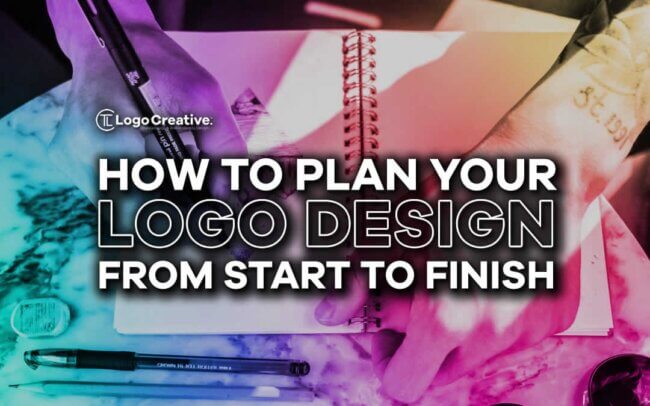Attention entrepreneurs and business owners! Did you know that a logo is often the first point of contact between your brand and potential customers? In this article we look at How to Plan Your Logo Design Project From Start to Finish.
Your logo is crucial in creating a memorable impression and conveying your brand’s values and personality. Studies show that companies with strong logo designs are perceived as more trustworthy and reliable than those without one.
But where do you even begin when it comes to planning a logo design project? That’s where this article comes in. We’ll take you through the process step-by-step, from the initial research and brainstorming phase to the final delivery of your logo files.
Whether starting from scratch or looking to refresh an existing logo, this guide will equip you with the tools and knowledge you need to create a logo that truly represents your brand.
Let’s dive in!
Table of Contents
Understanding the Project
The first step is understanding the project scope. What do you want your logo to accomplish? Who do you want it to appeal to? What makes your business unique compared to your competitors? By answering these questions, you can better identify the scope of your project and what elements you want to include in your logo.
Next, it’s important to determine your target audience. Who are you trying to reach? What are their preferences and values? Your logo design should speak to your target audience and convey a message that resonates.
So, to ensure your logo stands out in a crowded marketplace, you need to research your competition. What logos are your competitors using? What do they do well, and what can you improve upon? Understanding the competition can help you create a unique logo that sets you apart from the crowd.
Finally, you should establish goals for your logo design project. Do you want to increase brand awareness, attract new customers, or create a professional image? Setting clear goals ensures your logo design project stays on track and achieves the desired results.
Set up a Plan for Your Logo Design
When it comes to planning a logo design project, it’s important to take into account the team member count.
Whether it’s an in-house team, an external agency, or a freelancer, the approach to the project may vary.
You may have more control over the project if you have an in-house team, but you’ll need to consider their workload and availability. This will help you plan the project timeline and make sure that the team has enough resources to execute it.
On the other hand, if you decide to work with an external agency, you’ll have access to a larger pool of talent and resources. However, you’ll need to communicate your requirements clearly to ensure that they understand your vision and goals for the project.
Working with a freelancer can also be a great option, especially if you have a limited budget or a smaller project. However, you’ll need to carefully vet the talent and ensure they have the necessary skills and experience to deliver the project to your satisfaction.
In addition to considering the differences between in-house teams, external agencies, and freelancers, it’s also important to take into account any resource constraints that may affect your logo design project.
Resource constraints can include budget limitations, time constraints, and availability of tools and technology. For example, suppose you have a tight budget. In that case, you may need to prioritize which aspects of the logo design process to invest in, such as focusing on concept development and sketching over more expensive digital design software.
Similarly, if you are on a deadline, you may need to allocate more resources to speed up the process, like hiring additional designers or extending work hours. By considering resource constraints and adjusting your plan accordingly, you can ensure that your logo design project stays on track and meets your goals.
Creating a Design Brief
Now that you have a plan for your logo design project, it’s time to create a design brief. Think of a design brief as a roadmap for your logo designer. It helps to ensure that you and the designer are on the same page and working towards the same goals.
A design brief typically includes key elements, starting with your company’s background and history. This information helps the designer to understand where your company came from and where it’s headed.
Next, it’s important to identify your brand personality and values. This will inform the overall look and feel of your logo design.
Your target audience is another critical element of the design brief. Who are you trying to reach? What do they value and care about? Knowing your audience will help the designer create a logo that speaks directly to them.
Brainstorming and Concept Development
It’s time to get creative! Brainstorming and concept development are crucial steps in the logo design process. This is where you and your designer will collaborate to generate various ideas and explore different directions for your logo.
Brainstorming sessions are a great way to kick off the process. These sessions can take place in-person or virtually and involve generating as many ideas as possible. The key is to encourage a free flow of ideas and avoid judging or dismissing any concepts at this stage.
After the brainstorming session, it’s time to refine ideas and create sketches.
This is where your designer will take the most promising concepts and flesh them out in more detail. This process involves considering different colour schemes, font choices, and graphic elements.
Once your designer has created several sketches, it’s time to choose the best concepts for further development. This might involve getting feedback from your team, conducting focus groups, or simply trusting your gut.
Remember, the brainstorming and concept development phase is about exploring different options and refining ideas. By staying open-minded and collaborative, you can create a logo that represents your brand and resonates with your audience.
Refining the Design
Congratulations! You’ve made it to the refining stage of the logo design process. This is where your designer will take the concepts you’ve selected and turn them into a polished, finished design.
The first step in refining the design is incorporating feedback. This may involve getting input from key stakeholders or testing the design with a focus group. Your designer will consider this feedback and make necessary revisions to the design.
Once the revisions have been made, it’s time to get final approval from the client. This is your opportunity to review the design and ensure it meets your expectations. Take the time to review the design carefully and ask any questions or raise any concerns you may have.
Keep in mind that this is your logo, and it’s important that you feel confident and excited about the final product.
Some Logo Trends to Watch Out For
Regarding logo design, it’s important to stay on top of the latest trends and techniques. This can help your logo stand out and feel fresh and modern.
Let’s Dive deeper into some trending logo designs.
Animated logo
Animated logos are becoming increasingly popular in the world of branding. They allow you to take your static logo and add a new level of creativity, personality, and flair. By incorporating motion graphics, you can create an engaging and interactive experience for your audience that they will remember long after engaging with your brand.
Animated logos can be used across various mediums, including your website, social media channels, email signatures, and even in video ads. They can help to showcase your brand’s personality and differentiate you from competitors.
For example, a restaurant’s animated logo might feature the chef tossing a pizza in the air, or a salon’s animated logo might show scissors snipping a lock of hair.
3D Logo
3D logos are another trend that has been gaining popularity in recent years. Adding depth and texture to your logo can create a more immersive and engaging experience for your audience. A 3D logo can greatly impact your audience and set you apart from competitors.
A 3D logo can be designed to match your brand’s style and personality and can be used across various mediums, including websites, social media channels, and print materials.
A well-designed 3D logo can capture your audience’s attention and leave a lasting impression.
QR Code Logo
QR codes are a powerful tool that can be combined with your logo to create a seamless, integrated user experience. You can combine visual appeal with functionality by inserting your logo into a QR code.
For example, you can make a QR code, insert your logo inside the code and use the code in your creative marketing efforts.
So, QR codes can be a fun and engaging element in your branding. It can help your brand stand out and create a memorable customer experience.
A Thoughtful Plan Can Ensure the Perfect Logo Design
A logo is often the first point of contact between your brand and potential customers. Therefore, it plays a crucial role in creating a memorable impression and conveying your brand’s values and personality.
To ensure your logo stands out in a crowded marketplace, research your competition and establish goals for your logo design project. Then, create a design brief that includes your company’s background and history, brand personality and values, target audience, the scope of the project, and timeline.
Additionally, staying on top of the latest logo design trends can help your brand stand out in a crowded marketplace.
So, take the time to plan and execute your logo design project carefully, and you’ll reap the benefits of a strong brand identity and a memorable logo.
Join The Logo Community
We hope th How to Plan Your Logo Design Project From Start to Finish have been helpful. If you would like more personal tips, advice, insights, and access to our community threads and other goodies, join me in our community. You can comment directly on posts and have a discussion.
*TIP – We use and recommend DesignCuts for all your fonts, mockups and design bundles.
 Author Bio
Author Bio
Scarlett Finley is a results-driven affiliate marketing consultant with a proven track record driving business growth. She has a passion for helping businesses identify the right tools and strategies to optimize their growth potential.


